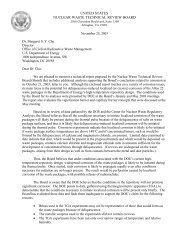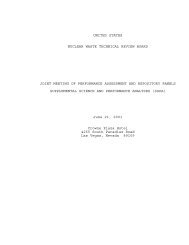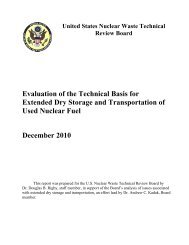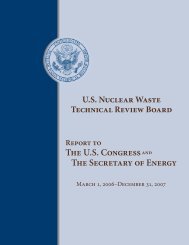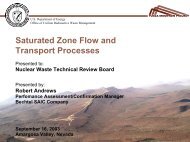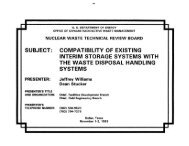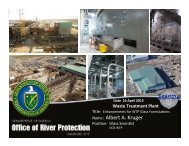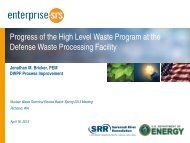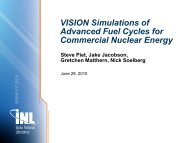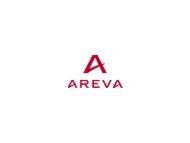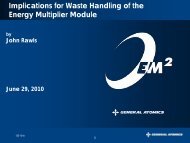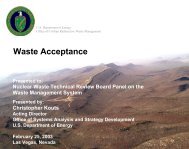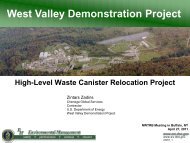Earl Easton - US Nuclear Waste Technical Review Board
Earl Easton - US Nuclear Waste Technical Review Board
Earl Easton - US Nuclear Waste Technical Review Board
You also want an ePaper? Increase the reach of your titles
YUMPU automatically turns print PDFs into web optimized ePapers that Google loves.
Recent Developments<br />
in the Full-Scale Testing<br />
of Spent Fuel Casks<br />
<strong>Nuclear</strong> <strong>Waste</strong> <strong>Technical</strong> <strong>Review</strong> <strong>Board</strong><br />
Salt Lake City, Utah<br />
October 12, 2004<br />
<strong>Earl</strong> <strong>Easton</strong><br />
Spent Fuel Project Office<br />
U.S. <strong>Nuclear</strong> Regulatory Commission
Approval Standards for<br />
Spent Fuel Shipping Casks<br />
• Spent Fuel Casks are certified to be accident resistant. They must<br />
withstand:<br />
– Thirty foot drop onto unyielding surface.<br />
– Forty inch drop onto a steel puncture pin.<br />
– Thirty minute fully engulfing 1475 o F fire.<br />
– Immersion Test (50 feet).
The NRC periodically assesses<br />
the effectiveness of Type B standards in<br />
addressing real world accidents.
Accident Studies by SANDIA, BAM, and CEGB<br />
Operation Smash Hit<br />
CEGB - Britain<br />
Rail Cask Collision - SANDIA<br />
Rail Fire - SANDIA<br />
Rail-Truck Collision - SANDIA<br />
Propane Tank Explosion<br />
BAM - Germany<br />
Truck Collision - SANDIA
Package Performance Study<br />
• Commission approved the testing of a fullscale,<br />
NRC certified rail transportation cask<br />
in May 2004<br />
– Authorized staff to purchase a single NRC<br />
certified rail cask<br />
– Realistically conservative test<br />
– Sufficient instrumentation to collect data for<br />
validating analytical methods, including scaling<br />
– Fully engulfing fire
Full-Scale Impact Testing<br />
• Completion of new drop test facility in<br />
Horstwalde, Germany<br />
• Full-scale drop tests<br />
– GNB-CONSTOR V/TC Cask<br />
– MHI-MSF69 BG Cask
Initial ground excavation and soil preparation
Excavation and lining of a cavity for the unyielding<br />
surface . (46 ft x 46ft x 16.5 ft).
Placement of steel reinforcement bars, and test<br />
instrumentation (force and strain gauges)
Pouring concrete for the unyielding surface
Initial construction work on enclosed test building
Finished skeleton of enclosed test building (left)<br />
and top of drop tower (right)
Top of drop tower being hoisted into place<br />
by an 80-ton portable crane.
Right: Close-up of cask<br />
release mechanism<br />
Left: 200- ton winch and<br />
cask release mechanism<br />
being hoisted into place<br />
at top of drop tower.
BAM Drop Test Facility in Horstwalde, Germany
BAM Drop Test Facility in<br />
Horstwalde, Germany<br />
Hoist Capacity<br />
Unyielding Surface<br />
Maximum<br />
weight of test<br />
object<br />
Maximum<br />
hook<br />
height<br />
Impact pad<br />
area<br />
(steel plate)<br />
Reinforced<br />
concrete<br />
block<br />
Steel<br />
reinforcement<br />
200 tons 30 feet 32x15x0.75 ft<br />
46x46x16.5 ft<br />
170,000 lbs.<br />
5.4 million lbs 225,000 lbs
GNB-CONSTOR V/TC Cask<br />
Full–Scale Drop Test<br />
Horstwalde, Germany<br />
September 21, 2004
GNB-CONSTOR V/TC Cask<br />
Side view after 9-meter side drop test
End view after 9-meter side drop test
MHI-MSF69 BG Cask<br />
Full–Scale Drop Test<br />
Horstwalde, Germany<br />
September 24, 2004
MHI-MSF69 BG Spent Fuel Cask being<br />
prepared for shallow angle drop test
Test preparation for MHI-MSF69 BG<br />
Spent Fuel Cask (shallow angle drop)
MHI-MSF69 BG Spent Fuel Cask<br />
after shallow angle (10 o ) drop test<br />
Side view<br />
End view
Concluding Remarks<br />
• Type B accident condition tests provide<br />
a high degree of protection against real<br />
life accidents.<br />
• NRC periodically re-assesses the<br />
effectiveness of Type B standards to<br />
reflect changes in package design and<br />
accident statistics.



